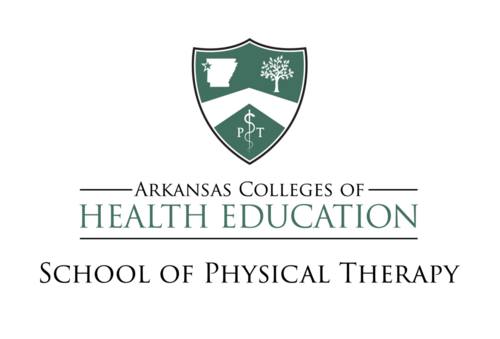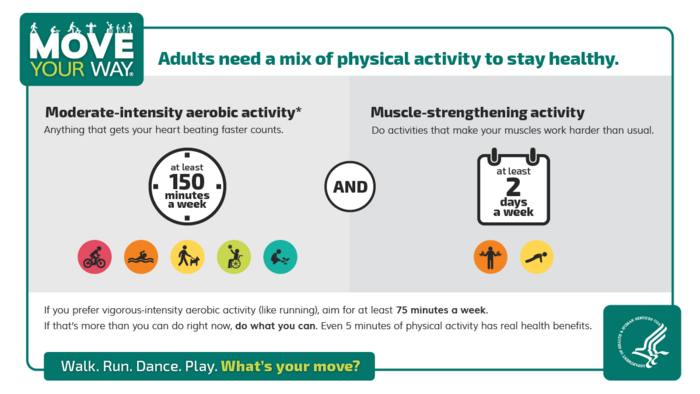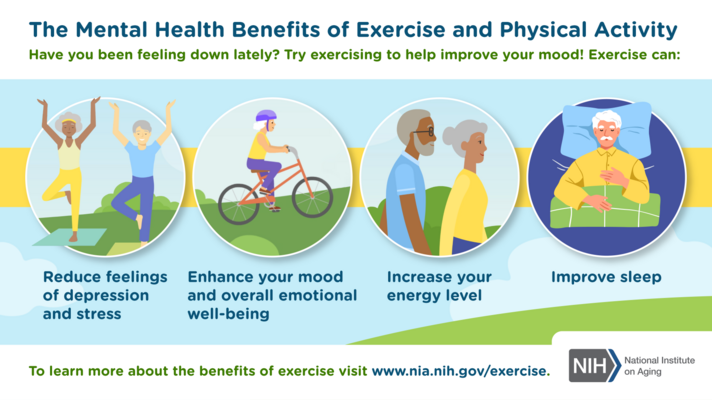Exercise as an Intervention of Holistic Medicine: Difference between revisions
(first section of holistic health.) |
No edit summary |
||
| Line 7: | Line 7: | ||
* '''The Body:''' What does your body need? Food, sleep, ''exercise'', or relaxation are all factors that may mitigate pain in the body, improve bodily health, or even prevent future diseases or injury. This might be what comes to mind when you hear the word "health". However, the body can influence, or be influenced by, other facets of holistic health.<ref name=":4" /> | * '''The Body:''' What does your body need? Food, sleep, ''exercise'', or relaxation are all factors that may mitigate pain in the body, improve bodily health, or even prevent future diseases or injury. This might be what comes to mind when you hear the word "health". However, the body can influence, or be influenced by, other facets of holistic health.<ref name=":4" /> | ||
* '''The | * '''The People:''' Connecting with people one of humanities most deepest and oldest practices. One of the most common goals for humans is to connect with those around them. Loved ones, friends, or peers have a significant impact on how you view yourself, the people around you, or how the world functions. Giving time, resources, and boundaries to those around you can positively impact the social aspect of holistic health.<ref name=":4" /> | ||
* '''The | * '''The Spirit:''' Humans have a natural desire to connect with something superior to ourselves. This gives us a deep purpose and additional meaning to pursue living to its extreme. If your sense of purpose is hindered, this will take a toll on other aspects of your health.<ref name=":4" /> | ||
* '''The | * '''The Mind:''' Your mind has needs just like your body does. If it is not receiving adequate stimulation or is not being taken care of in terms of mental health, the mind's connections to your overall wellbeing might be influenced negatively.<ref name=":4" /> | ||
* '''The | * '''The Environment:''' Your home, neighborhood, geography, etc. are all factors that can impact other aspects of your health. For instance, if you live in a neighborhood that is in close proximity to a highway, your sleep might be disturbed from too much noise. Or, it may just provide you with a sense of stress. Either way, your mental health or physical health can be impacted from the environmental factors listed. Therefore, it is important to take into account what type of environment you live in to reduce negative influences on your holistic health.<ref name=":4" /> | ||
''Exercise'' is a tool that can be used to mitigate, prevent, or even treat pain, disease or illnesses. Exercise can even influence multiple factors of holistic health such as the body and the mind in a positive fashion. This is an important point of knowledge that the general public may not be well educated on. In the following sections, there is evidence showing why it is so important to incorporate the tool of exercise into the daily lives of humans. | ''Exercise'' is a tool that can be used to mitigate, prevent, or even treat pain, disease or illnesses. Exercise can even influence multiple factors of holistic health such as the body and the mind in a positive fashion. This is an important point of knowledge that the general public may not be well educated on. In the following sections, there is evidence showing why it is so important to incorporate the tool of exercise into the daily lives of humans. | ||
Revision as of 19:39, 7 April 2024
Welcome to Arkansas Colleges of Health Education School of Physical Therapy Musculoskeletal 1 Project. This space was created by and for the students at Arkansas Colleges of Health Education School in the United States. Please do not edit unless you are involved in this project, but please come back in the near future to check out new information!
Holistic Medicine- Everything Matters[edit | edit source]
Holistic medicine considers the whole person and addresses the underlying causes of health-related issues rather than focusing on symptoms alone. A holistic approach involves the incorporation and treatment of the spirt, body, and mind while simultaneously considering the emotions, culture, and environment that an individual may experience.[1] While modern-day medicine has developed life-saving medical advancements, it has wired society to look at health in terms of symptoms present rather than looking at the individual in their entirety. Each individual is composed of interdependent parts that work together and impact overall well-being. This includes, but is not limited to the following aspects:
- The Body: What does your body need? Food, sleep, exercise, or relaxation are all factors that may mitigate pain in the body, improve bodily health, or even prevent future diseases or injury. This might be what comes to mind when you hear the word "health". However, the body can influence, or be influenced by, other facets of holistic health.[1]
- The People: Connecting with people one of humanities most deepest and oldest practices. One of the most common goals for humans is to connect with those around them. Loved ones, friends, or peers have a significant impact on how you view yourself, the people around you, or how the world functions. Giving time, resources, and boundaries to those around you can positively impact the social aspect of holistic health.[1]
- The Spirit: Humans have a natural desire to connect with something superior to ourselves. This gives us a deep purpose and additional meaning to pursue living to its extreme. If your sense of purpose is hindered, this will take a toll on other aspects of your health.[1]
- The Mind: Your mind has needs just like your body does. If it is not receiving adequate stimulation or is not being taken care of in terms of mental health, the mind's connections to your overall wellbeing might be influenced negatively.[1]
- The Environment: Your home, neighborhood, geography, etc. are all factors that can impact other aspects of your health. For instance, if you live in a neighborhood that is in close proximity to a highway, your sleep might be disturbed from too much noise. Or, it may just provide you with a sense of stress. Either way, your mental health or physical health can be impacted from the environmental factors listed. Therefore, it is important to take into account what type of environment you live in to reduce negative influences on your holistic health.[1]
Exercise is a tool that can be used to mitigate, prevent, or even treat pain, disease or illnesses. Exercise can even influence multiple factors of holistic health such as the body and the mind in a positive fashion. This is an important point of knowledge that the general public may not be well educated on. In the following sections, there is evidence showing why it is so important to incorporate the tool of exercise into the daily lives of humans.
What is Exercise?[edit | edit source]
Terms such as 'exercise', 'physical activity', and 'physical fitness' are often used interchangeably but the framework of each is slightly different. Exercise is defined as a subset of physical activity that is planned, structured, and repetitive with a final or intermediate objective in mind.[2] This objective might differ between individuals; some may have an interest in losing weight to feel better in their skin whereas others may be taking action for their physical or mental health. Exercise can influence a large spectrum that includes impairments, dysfunctions, diseases illnesses, and disabilities that currently plague the world.
Types of Exercise[edit | edit source]
There are 5 main types of physical activity:
- Endurance/Aerobic Exercise: This type of exercise specifically aims to increase your heart rate and breathing rate. If this type of exercise is consistent, your lungs, heart, and circulatory system will also become more fit as a result. Examples include brisk walking, jogging, swimming, biking, playing sports like tennis, and even yard work.[3]
- Strengthening Exercise: Strength exercise doesn't have to be limited to using only dumbbells. To strengthen your muscles, you can perform any type of exercise that involves moving weight or resistance with a specific muscle group. An example would be doing bicep curls with a resistance band. Other examples of strengthening exercises include push-ups, squats, and lifting weights.[3]
- Balance Exercise: Practicing and bettering your balance skills is essential to preventing falls that may accompany old age. It may also aid in the efficiency and accuracy of other forms of exercise. Examples of balance exercises include Tai Chi, tandem walking, standing on one foot, or standing up from a seated position.[3]
- Flexibility Exercise: Increasing flexibility usually results from performing stretches. Flexibility can affect many different Activities of Daily Living (ADLs) in a positive or negative way. Examples of stretches to improve flexibility are: ankle stretches, back stretches, and even some yoga poses.[3]
- Mind-Body Movement Practices: Body movement, mental focus, and controlled breathing together form a multicomponent exercise to help improve strength, balance, and flexibility. Examples of mind-body movement exercises include yoga, Tai Chi, Qigong, and walking meditation.[4]
Note: If you feel unsafe performing an exercise or do not think you would be able to perform an exercise alone, talk with your physical therapist. Always remember to breathe while you are exercising and drink water. Do not continue exercise if you feel a sudden onset of pain and be sure to speak with your physical therapist.[3]
How Much Exercise Do I Need?[edit | edit source]
The US Government recommends adults complete at least 150 minutes of moderate-intensity aerobic activity and perform at least 2 days of muscle-strengthening activity per week.[5] This recommendation is the minimal requirement to maintain good health. Aerobic exercise accompanied by resistance training can offset body degradation on several levels. This includes but is not limited to balance, walking speed, muscle strength, and neurodegenerative changes that affect cognition and memory.[6] In a research study published in Journal Circulation, adults who partake in more exercise than the recommended amount have a reduced risk of mortality. This study also supports the current physical activity guidelines and further suggests that physical activity has a direct correlation with lower mortality.[7] Moreover, a holistic approach often incorporates a well-rounded approach that often exceeds the recommendations provided for the nation to maintain quality of life.
Benefits of Exercise[edit | edit source]
- Exercise can help you maintain, lose, or gain weight.[8]
- Exercise can prevent certain health conditions and diseases.[8]
- Stroke
- Metabolic Syndrome
- High Blood Pressure
- Type 2 Diabetes
- Mental Health Disorders
- Anxiety
- Depression
- Cancer
- Osteoporosis
- Exercise has shown to slow the progression of Parkinson's disease.[9]
- Exercise helps regulate chemicals within the brain to improve mood.[8]
- Long-term exercise leads to elevated energy levels.[8]
- Regular exercise can help you sleep better at night.[8]
- Exercise can offer sexual benefits.[8]
- Increases your libido.
- Increased confidence in your own physical appearance.
- Exercise can be a social event.[8]
- Exercise can prevent neurodegenerative changes.
Exercise is Medicine®[edit | edit source]
Exercise is Medicine is a health initiative created by the American College of Sports Medicine that is working to make the assessment and promotion of physical activity a healthcare standard.[10]
The negative effects of exercise are widely known; however, there is a lack of information provided to patients in the clinic about the positive effects exercise can have on our lives. Healthcare providers must inform their patients of the risks of being sedentary and prescribe regular exercise to their patients. The lack of time available for primary care practitioners to spend with patients often causes physical activity to be placed lower on the priority list of recommendations. Physical therapists should be having this conversation with their patients and encouraging patients to obtain at minimum the recommended levels of exercise. [11]
Longevity with Exercise[edit | edit source]
In a world where stress is predominant and sedentary lifestyles are common, it is important to utilize physical activity and exercise to promote longevity. The British Journal of Sports Medicine published a study that found that regular exercise can increase life expectancy by up to 7 years.[12] By developing a routine and incorporating exercise, the benefits will outweigh the burdens.
However, if exercise is omitted or neglected, it can be very detrimental to overall health. Lack of exercise in a consistent routine can potentially lead to the onset of 40 chronic health conditions, including premature mortality.[13] There have been 7 different types of cancer that have been linked to a sedentary, or physically inactive, lifestyle; there is also an increased risk of depression with insufficient exercise in weekly routines.[11] Evidence has shown that exercise can be utilized as a treatment method for multiple diseases. This is because exercise reduces the risk of onset and can counteract the progression of disease. Exercise, or lack thereof, can be critical in affecting the health and well-being of a person.
How does Exercise influence Holistic Approaches to Medicine?[edit | edit source]
If exercise was prescribed alongside pharmaceutical medications, patients would see positive changes in their overall health. Incorporating exercise into a medicinal approach invites other benefits that treat more than the symptoms of illness and offers a more holistic care plan. Physical therapists should prescribe exercise as a means of prevention as well as for recovery and pain management. Exercise can prevent the development of adverse psychosocial diagnoses such as depression and anxiety as well as adverse diagnoses related to cardiovascular health.[14] If physical therapists prescribed exercise in a preventive manner the likelihood of these patients attending treatment for adverse diagnoses in the future would decline. Overall, patients have shown to benefit from holistic healthcare approaches and exercise is key to implement within a patient's plan of care.
References[edit | edit source]
- ↑ 1.0 1.1 1.2 1.3 1.4 1.5 St. Catherine University. What is holistic health? Available from: https://www.stkate.edu/healthcare-degrees/what-is-holistic-health (accessed 4 April 2024)
- ↑ Caspersen CJ, Powell KE, Christenson GM. Physical activity, exercise, and physical fitness: definitions and distinctions for health-related research. Public Health Reports 1974;100:126-131
- ↑ 3.0 3.1 3.2 3.3 3.4 National Institute on Aging. Four types of exercise can improve your health and physical ability. Available from: https://www.nia.nih.gov/health/exercise-and-physical-activity/four-types-exercise-can-improve-your-health-and-physical (accessed 4 April 2024)
- ↑ The Medicinal Cannabis Library. Understanding the holistic approach. Available from: https://www.polln.com/medicinal-cannabis-library/holistic-health-you (accessed 4 April 2024)
- ↑ Centers for Disease Control and Prevention. Move more; sit less. Available from: https://www.cdc.gov/physicalactivity/basics/adults/index.htm (accessed 4 April 2024)
- ↑ Bonanni R, Cariati I, Tarantino U, D'Arcangelo G, Tancredi V. Physical exercise and health: a focus on its protective role in neurodegenerative diseases. Journal of Functional Morphology and Kinesiology 2022;7:38
- ↑ Lee DH, Rezende LFM, Joh H-K, Keum N, Ferrari G, Pablo Rey-Lopez J, Rimm EB, Tabung FK, Giovannucci EL. Long term leisure-time physical activity intensity and all-cause and cause-specific mortality: a prospective cohort of US adults. AHA Journals 2022;146:523-534
- ↑ 8.0 8.1 8.2 8.3 8.4 8.5 8.6 Mayo Clinic. Exercise: 7 benefits of regular physical activity. Available from: https://www.mayoclinic.org/healthy-lifestyle/fitness/in-depth/exercise/art-20048389 (accessed 4 April 2024)
- ↑ Crotty GF, Schwarzschild MA. Chasing protection in parkinson's disease: does exercise reduce risk and progression? Frontiers in Aging Neuroscience 2020;12:186
- ↑ Exercise is Medicine. Exercise is medicine: a global health initiative. Available from https://www.exerciseismedicine.org/ (accessed 4 April 2024)
- ↑ 11.0 11.1 Thompson WR, Sallis R, Joy E, Jaworski CA, Stuhr RM, Trilk JL. Exercise is medicine. American Journal of Lifestyle Medicine. 2020;14:511-523
- ↑ Reimers CD, Knapp G, Reimers AK. Does physical activity increase life expectancy? a review of the literature. Journal of Aging research 2012;2012:1-9
- ↑ Ruegsegger GN, Booth FW. Health benefits of exercise. Cold Spring Harbor Perspectives in Medicine 2018;8
- ↑ U.S. Department of Health and Human Services. Physical activity and health: a report of the surgeon general. Available from: https://www.cdc.gov/nccdphp/sgr/pdf/sgrfull.pdf (accessed 4 April 2024)









